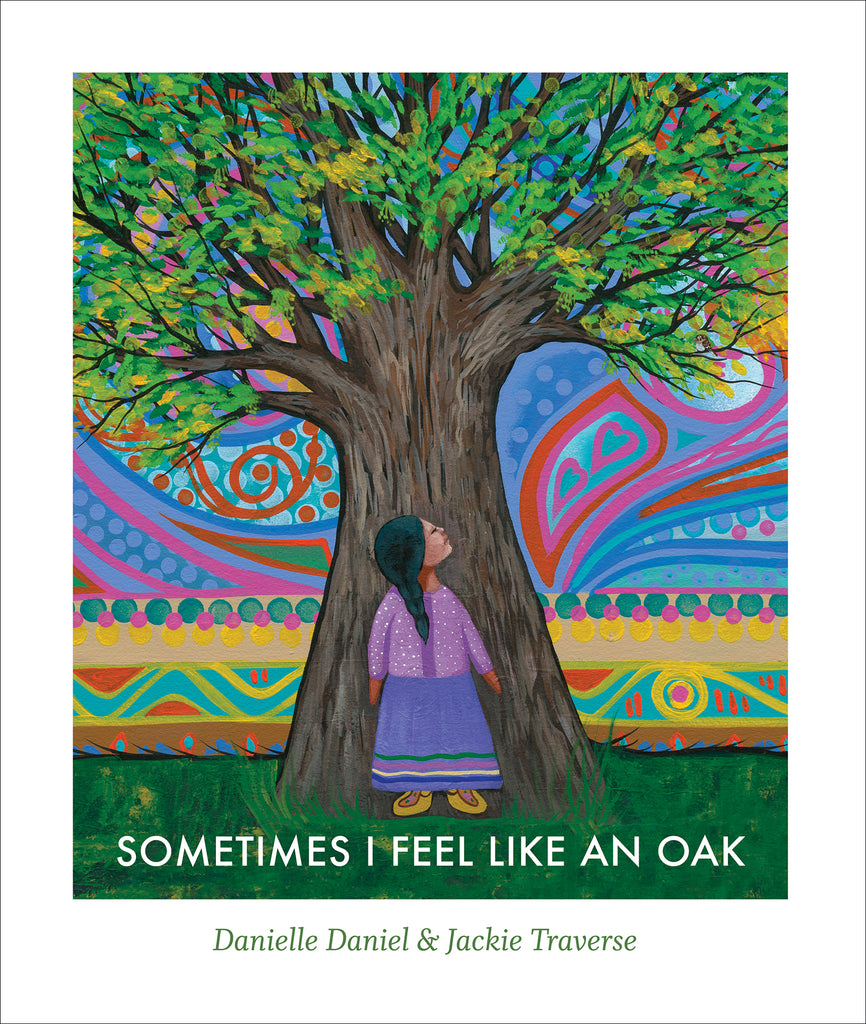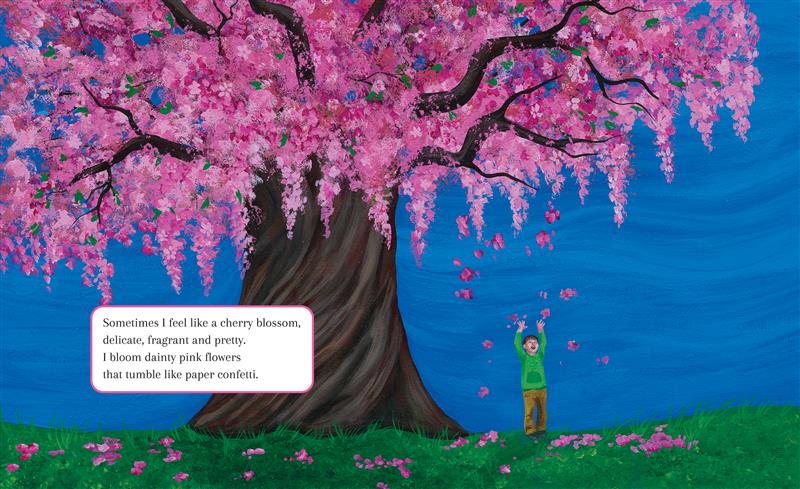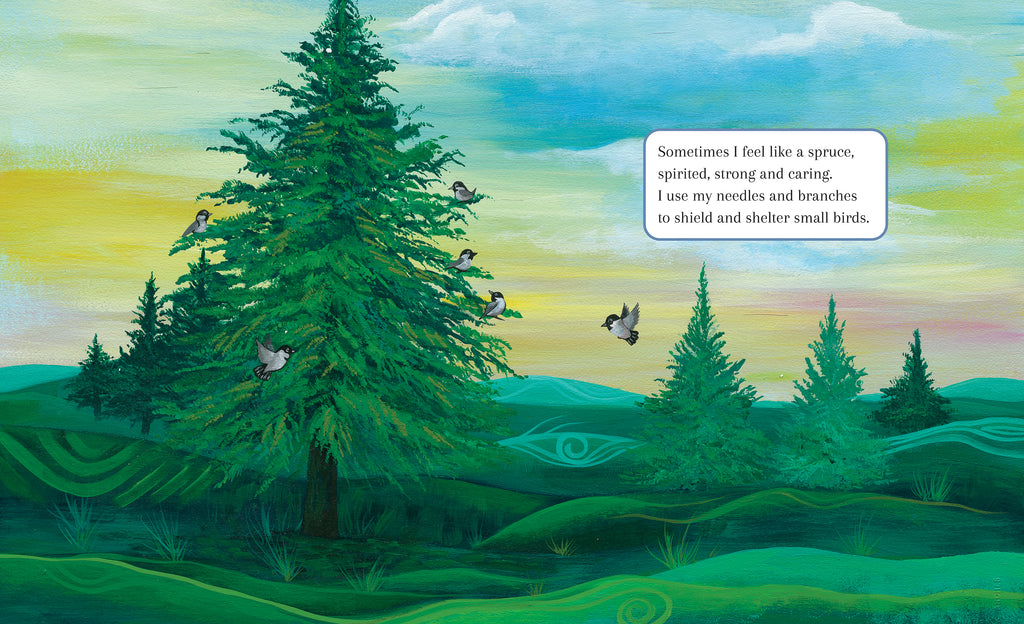Following the success of Sometimes I Feel Like a Fox and Sometimes I Feel Like a River, this companion book explores the nature and beauty of trees.
Twelve lyrical poems look at twelve different trees, from early spring to deep winter. In each poem, a child identifies with a feature of the tree — such as the smooth trunk of a birch whose bark has peeled away, the strong branches of a spruce that shelter small birds or the pink flowers of a cherry blossom that tumble like confetti. The poems provide an opportunity to learn about each tree, inspiring us to look afresh at the trees around us — whether in the schoolyard, neighborhood or park — and get to know them better.
Danielle Daniel’s passion for trees is beautifully matched by Jackie Traverse’s paintings, which bring each tree to life. In the pages following the poems, children are invited to consider what different kinds of trees might mean to them. In an author’s note, Danielle Daniel shares her belief, similar to her Algonquin ancestors’, that trees are sentient beings with much to give and teach us.
Key Text Features
illustrations
author’s note
poems
Correlates to the Common Core States Standards in English Language Arts:
CCSS.ELA-LITERACY.RL.K.5
Recognize common types of texts (e.g., storybooks, poems).
CCSS.ELA-LITERACY.RL.K.6
With prompting and support, name the author and illustrator of a story and define the role of each in telling the story.
CCSS.ELA-LITERACY.RL.1.4
Identify words and phrases in stories or poems that suggest feelings or appeal to the senses.
Following the success of Sometimes I Feel Like a Fox and Sometimes I Feel Like a River, this companion book explores the nature and beauty of trees.
Twelve lyrical poems look at twelve different trees, from early spring to deep winter. In each poem, a child identifies with a feature of the tree — such as the smooth trunk of a birch whose bark has peeled away, the strong branches of a spruce that shelter small birds or the pink flowers of a cherry blossom that tumble like confetti. The poems provide an opportunity to learn about each tree, inspiring us to look afresh at the trees around us — whether in the schoolyard, neighborhood or park — and get to know them better.
Danielle Daniel’s passion for trees is beautifully matched by Jackie Traverse’s paintings, which bring each tree to life. In the pages following the poems, children are invited to consider what different kinds of trees might mean to them. In an author’s note, Danielle Daniel shares her belief, similar to her Algonquin ancestors’, that trees are sentient beings with much to give and teach us.
Key Text Features
illustrations
author’s note
poems
Correlates to the Common Core States Standards in English Language Arts:
CCSS.ELA-LITERACY.RL.K.5
Recognize common types of texts (e.g., storybooks, poems).
CCSS.ELA-LITERACY.RL.K.6
With prompting and support, name the author and illustrator of a story and define the role of each in telling the story.
CCSS.ELA-LITERACY.RL.1.4
Identify words and phrases in stories or poems that suggest feelings or appeal to the senses.
| Published By | Groundwood Books Ltd — Apr 2, 2024 |
| Specifications | 32 pages | 8.25 in x 10 in |
| Keywords | seasons; senses; emotions; moods and feelings; self awareness; mindfulness; personality types; Forever Birchwood; Daughters of the Deer; Indigenous artists; traditional knowledge; |
| Written By |
DANIELLE DANIEL is an award-winning author and illustrator whose journey into artmaking and book publishing has gone hand in hand with all she has learned—and continues to learn—about her Indigenous ancestry and her relationship with the land. Her picture books include Sometimes I Feel Like a Fox (Marilyn Baillie Picture Book Award), Sometimes I Feel Like a River and Once in a Blue Moon. She has also written novels for children and adults. Danielle lives on Manitoulin Island with her family. |
| Illustrated by |
JACKIE TRAVERSE is Ojibway, from Lake St. Martin First Nation. She graduated in Fine Arts from the University of Manitoba and works as a multidisciplinary artist in oil and acrylics, mixed media, stop-motion animation and sculpture, but her happiest moments are when she is painting. She draws inspiration from her culture for her art, which often speaks to the realities of being an Indigenous woman. Her award-winning work appears in numerous private and public collections. Jackie lives in Winnipeg, Manitoba. |
| Written By |
|
DANIELLE DANIEL is an award-winning author and illustrator whose journey into artmaking and book publishing has gone hand in hand with all she has learned—and continues to learn—about her Indigenous ancestry and her relationship with the land. Her picture books include Sometimes I Feel Like a Fox (Marilyn Baillie Picture Book Award), Sometimes I Feel Like a River and Once in a Blue Moon. She has also written novels for children and adults. Danielle lives on Manitoulin Island with her family. |
| Illustrated by |
|
JACKIE TRAVERSE is Ojibway, from Lake St. Martin First Nation. She graduated in Fine Arts from the University of Manitoba and works as a multidisciplinary artist in oil and acrylics, mixed media, stop-motion animation and sculpture, but her happiest moments are when she is painting. She draws inspiration from her culture for her art, which often speaks to the realities of being an Indigenous woman. Her award-winning work appears in numerous private and public collections. Jackie lives in Winnipeg, Manitoba. |
| Audience | ages 3 to 6 / grades P to 1 |
| Reading Levels | Lexile AD780L |
| Key Text Features | illustrations; author’s note; poems |
| Common Core |
CCSS.ELA-LITERACY.RL.K.6
CCSS.ELA-LITERACY.RL.K.5 CCSS.ELA-LITERACY.RL.1.4 |
“A relevant book for a world dealing with environmental crises.” — Quill & Quire, STARRED REVIEW
“This simple story will invite children to relate to trees as teachers and healers ... Tender and thought provoking.” — Kirkus Reviews
“Daniel's latest offering invites readers to commune with trees.” — Horn Book
“This is a moving addition to Daniel's previous explorations of Indigenous culture, Sometimes I Feel Like a Fox and Sometimes I Feel Like a River.” — Globe and Mail
“Aesthetic and therapeutic ... Even the attentive grown-up might learn a thing or two.” — Literary Review of Canada




